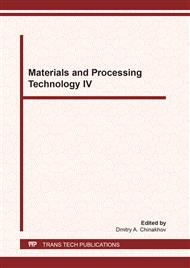[1]
Grinyuk, B.C Proizvodstvo krupnyh shtampovyh zagotovok metodom ESHL. Problemy specialnoj elektrometallurgii. № 8 (1978), pp.31-38.
Google Scholar
[2]
Kubarev B.I., Shaparov, V.V. Izgotovlenie detalej metodom EShP i EShL. Informacionnyj listok: 007-78, series 10-05. - M.: NIIINFORMTYAZHMASH. - (1978).
Google Scholar
[3]
A.s. 383530 SSSR MKI V22D. Ekzotermicheskaya shlakoobrazuyushaya smes/ A.M. Uznenko i dr. (SSSR). - № 1682680 / 02.22; stated 09.08.71; publ. 1973; Bull. № 24.
Google Scholar
[4]
A.s. 926025 SSSR MKI3 V22D. Ekzotermicheskaya smes dlya rafinirovaniya metalla/ N.F. Parahin i dr. - № 2966952 / 02.22; stated 07.29.80; opubl.1982; Bulletin 17.
Google Scholar
[5]
Kowal, A.K., Lyamtsev K.K. Vliyanie sposobov degazacii flyusa i zashity plavilnogo prostranstva na povedenie vodoroda pri EShP. Problemy specialnoj metallurgii. № 11 (1979). S. 13-19.
Google Scholar
[6]
Paton, B.E., Medovar, B.I. Elektroshlakovyj metal. –Kiev: Naukova Dumka, 1981. 680 s.
Google Scholar
[7]
Paton, B.E., Medovar, B.I., Boyko G.A. Elektroshlakovoe lit`e. M.: NIImash, 1974. 68 s.
Google Scholar
[8]
Vlasov, A.F. Chigarev, V.V., Makarenko, N.A. Ekzotermicheskie smesi i flyusy v svarochnom i metallurgicheskom proizvodstvah: monografiya. Kramatorsk: DGMA, 2015. 367 s. ISBN 978-966-379-752-6.
Google Scholar
[9]
Makarenko, N.A., Vlasov A.F., Volkov D.A., Kuschy, A.M. Issledovanie i razrabotka sostavov ekzotermicheskih flyusov dlya elektroshlakovyh processov. Sovremennaya elektrometallurgiya. Kiev. № 2 (2015), pp.10-16.
Google Scholar
[10]
Vlasov, A.F. Makarenko, N.A., Chigarev, V.V., Volkov, D.A. Fizicheskaya model elektroshlakovogo processa na tverdom, starte s primeneniem ekzotermicheskih elektroprovodnyh flyusov. Tehnologiya mashinostroeniya. № 5 (2015), pp.56-60.
Google Scholar
[11]
Vlasov, A.F., Boguckij, A.A. Elektroshlakovyj pereplav na tverdom, starte po monofilyarnoj sheme vedeniya processa s ispolzovaniem ekzotermicheskih elektroprovodnyh flyusov. Tehnologiya mashinostroeniya. № 2 (2015), pp.5-10.
Google Scholar
[12]
Vlasov, A.F. Makarenko, N.A. Elektroshlakovyj pereplav na tverdom, starte po bifilyarnoj sheme vedeniya processa s ispolzovaniem ekzotermicheskih elektroprovodnyh flyusov. Svarochnoe proizvodstvo. № 4 (2014), pp.20-25.
Google Scholar
[13]
Vlasov, A.F. Vliyanie elektroshlakovogo pereplava na svojstva litoj shtampovoj stali X5CrNiMo. Problemy specialnoj elektrometallurgii. № 2 (1989), pp.23-29.
Google Scholar
[14]
Vlasov, A.F. Elektroshlakovoe lite kolenchatogo vala gazomotokompressora MK-08 iz stali X34CrNiMo s ispolzovaniem ekzotermicheskih elektroprovodnyh flyusov. Tehnologiya mashinostroeniya. № 9 (2013), pp.10-15.
Google Scholar
[15]
A.s. 1533346 SSSR. SU A1. С22 В9/18. Sposob starta elektroshlakovogo pereplava / A.F. Vlasov i dr. (SSSR). Zayavl.16.02.88, ne publ.
Google Scholar
[16]
Shkolnik, L.M. Metodika ustalostnyh ispytanij. Spravochnik, M.: Metallurgiya. - 1978. 304 p.
Google Scholar
[17]
Yuzhanin, Zh.I., Tsipunova, I.R., Agafonov, A.S. Izgotovlenie zagotovok kontejnernyh vtulok iz stali X5CrNiMo s pomoshyu elektroshlakovogo litya. Metallovedenie i termicheskaya obrabotka. № 6 (1979), pp.53-55.
Google Scholar
[18]
Kudryavtsev, I.V., Naumchenko, N.E., Savina N.M. Ustalost krupnyh detalej mashin. M.: Mashinostroenie, 1981. 240 p.
Google Scholar
[19]
Chinakhov D.A., Grigorieva E.G., Mayorova E.I. Study of gasdynamic effet upon the weld geometry when concumable electrode welding. IOP Conf. Series: Materials Science and Engineering 127 (2016) 012013.
DOI: 10.1088/1757-899x/127/1/012013
Google Scholar
[20]
Chinakhov D.A., Agrenich E.P. Computer simulation of thermo-mechanical processes at fusion welding of alloyed steels. Materials Science Forum. Vols. 575-578 (2008). Pp. 833-836.
DOI: 10.4028/www.scientific.net/msf.575-578.833
Google Scholar
[21]
Chinakhov D.A., Grigorieva E.G., Mayorova E.I., Kartsev D.S. The influence of shielding gas flow rate on the transfer frequency of electrode metals drops. IOP Conf. Series: Materials Science and Engineering 142 (2016) 012005.
DOI: 10.1088/1757-899x/142/1/012005
Google Scholar
[22]
Markov, O.E., Gerasimenko, O.V., Kukhar, V.V., Abdulov, O.R., & Ragulina, N.V. (2019). Computational and experimental modeling of new forging workpieces with a directional solidification: the relative heights of 1.1. Journal of the Brazilian Society of Mechanical Sciences and Engineering, 41(8), 310. http://doi.org/10.1007/s40430-019-1810-z.
DOI: 10.1007/s40430-019-1810-z
Google Scholar
[23]
Markov, O.E., Gerasimenko, O.V., Shapoval, A.A., Abdulov, O.R., & Zhytnikov, R.U. (2019). Computerized simulation of shortened workpieces with a controlled crystallization for manufacturing of high-quality forgings. The International Journal of Advanced Manufacturing Technology, 103, 3057–3065. doi: http://doi.org/10.1007/s00170-019-03749-4.
DOI: 10.1007/s00170-019-03749-4
Google Scholar
[24]
Markov, O, Zlygoriev, V, Gerasimenko, O, Hrudkina, N, Shevtsov, S (2018) Improving the quality of forgings based on upsetting the workpieces with concave facets. Eastern-European Journal of Enterprise Technologies 5/1(95): 16-24. http://doi.org/10.15587/1729-4061.2018.142674.
DOI: 10.15587/1729-4061.2018.142674
Google Scholar
[25]
Markov, O.E., Perig, A.V., Zlygoriev V.N., Markova M.A., Kosilov, M.S. (2017) Development of forging processes using intermediate workpiece profiling before drawing: research into strained state. J Braz. Soc. Mech. Sci. Eng. 39(4): 4649–4665. https://doi.org/10.1007/S40430-017-0812-Y.
DOI: 10.1007/s40430-017-0812-y
Google Scholar


